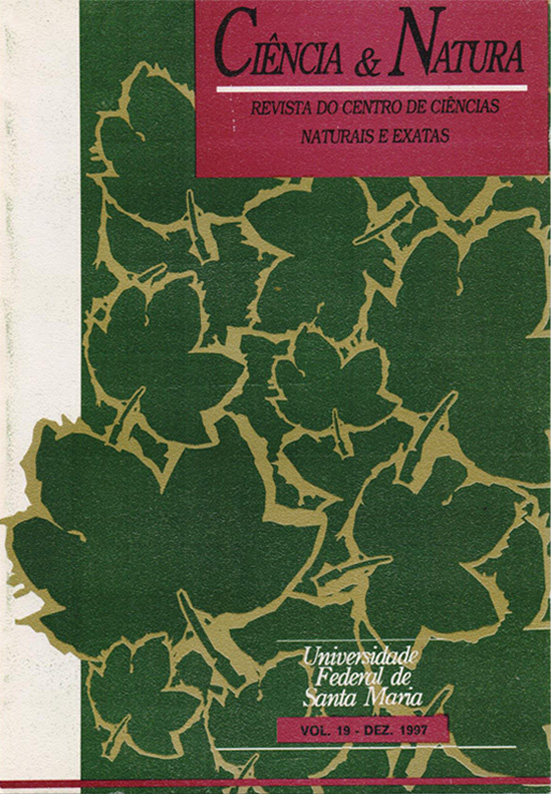Student's opinion on a problem-based learning method of teaching comparative animal physiology
DOI:
https://doi.org/10.5902/2179460X26718Resumo
o objetivo deste trabalho foi verificar qual a opinião dos alunos em relação a uma metodologia de ensino onde o que importa não é o acúmulo ou a memorização de determinados conhecimentos, e sim o raciocínio frente a problemas relacionados com a matéria e sua resolução. Este trabalho utilizou alunos matriculados na disciplina "Fisiologia Animal Comparada" (turmas com 10 a 15 alunos), da Universidade Federal de Santa Maria. Em cada aula os alunos discutiam a possível resposta a uma pergunta fornecida pelo professor, baseados na bibliografia fornecida, e entregavam posteriormente um relatório escrito com as conclusões obtidas. A avaliação dos alunos foi feita tendo como base os relatórios apresentados. No final dos semestres os alunos (44 no total) responderam por escrito (anonimamente) a um questionário de avaliação do método, comparando-o com um sistema de aula expositiva. Segundo os alunos, comparado ao sistema de aula expositiva, o método utilizado apresenta uma visão menos abrangente da matéria, mas desperta mais interesse pelo tema que está sendo visto e melhora o aproveitamento do aluno. Não há diferença entre os dois métodos com relação ao esclarecimento de dúvidas. Os alunos não acharam que perderam muito tempo na tradução de textos em inglês. A grande maioria prefere este sistema ao de aulas expositivas, e a metodologia de avaliação teve aprovação unânime. Os dados obtidos permitem concluir que este método pode ser utilizado no ensino de Fisiologia Animal Comparada com bons resultados.
Downloads
Referências
Ávila Pires, F.D. Perfis e caricaturas: reflexões sobre a formação do biólogo. Cien. Cult., v.36, n.10, p.1762-64, 1984.
Beraldo, W.T.; Alvarenga, G.P. Non-directive method for teaching physiology. The Physiologist, v.26, n,4, p.229-30, 1983.
Libâneo, J.C. Democratização da escola pública: a pedagogia crítico-social dos conteúdos. 7.ed., Edições Loyola, São Paulo, 1984.
Moreira, E.S.A.; Caixeta, F.N.; Carvalho, H.C.; Beirão, P.S.L. Ciclo básico em questão. Ciência Hoje, v.13, n.78, p.18-20, 1991.
Rangachari, P.K. Design of a problem-based undergraduate course in pharmacology: implications for the teaching of physiology. Am. J. Physiol., v.260, p. S14-21, 1991.
Richardson, D.; Birge, B. Teaching physiology by combined passive (pedagogical) and active (andragogical) methods. Am. J. Physiol., v.268, p. S66-74, 1995.
Xavier, G.F.; Sawaya, M.I.; Mimura, O.M.; Freitas, J.C. Uma abordagem de ensino visando a participação ativa do aluno. Cien. Cult., v. 38, n. 10, p.1671-74,1986.
Downloads
Publicado
Como Citar
Edição
Seção
Licença
Para acessar a DECLARAÇÃO DE ORIGINALIDADE E EXCLUSIVIDADE E CESSÃO DE DIREITOS AUTORAIS clique aqui.
Diretrizes Éticas para Publicação de Revistas
A revista Ciência e Natura está empenhada em garantir a ética na publicação e na qualidade dos artigos.
A conformidade com padrões de comportamento ético é, portanto, esperada de todas as partes envolvidas: Autores, Editores e Revisores.
Em particular,
Autores: Os Autores devem apresentar uma discussão objetiva sobre a importância do trabalho de pesquisa, bem como detalhes e referências suficientes para permitir que outros reproduzam as experiências. Declarações fraudulentas ou intencionalmente incorretas constituem comportamento antiético e são inaceitáveis. Artigos de Revisão também devem ser objetivos, abrangentes e relatos precisos do estado da arte. Os Autores devem assegurar que seu trabalho é uma obra totalmente original, e se o trabalho e / ou palavras de outros têm sido utilizadas, isso tem sido devidamente reconhecido. O plágio em todas as suas formas constitui um comportamento publicitário não ético e é inaceitável. Submeter o mesmo manuscrito a mais de um jornal simultaneamente constitui um comportamento publicitário não ético e é inaceitável. Os Autores não devem submeter artigos que descrevam essencialmente a mesma pesquisa a mais de uma revista. O Autor correspondente deve garantir que haja um consenso total de todos os Co-autores na aprovação da versão final do artigo e sua submissão para publicação.
Editores: Os Editores devem avaliar manuscritos exclusivamente com base no seu mérito acadêmico. Um Editor não deve usar informações não publicadas na própria pesquisa do Editor sem o consentimento expresso por escrito do Autor. Os Editores devem tomar medidas de resposta razoável quando tiverem sido apresentadas queixas éticas relativas a um manuscrito submetido ou publicado.
Revisores: Todos os manuscritos recebidos para revisão devem ser tratados como documentos confidenciais. As informações ou ideias privilegiadas obtidas através da análise por pares devem ser mantidas confidenciais e não utilizadas para vantagens pessoais. As revisões devem ser conduzidas objetivamente e as observações devem ser formuladas claramente com argumentos de apoio, de modo que os Autores possam usá-los para melhorar o artigo. Qualquer Revisor selecionado que se sinta desqualificado para rever a pesquisa relatada em um manuscrito ou sabe que sua rápida revisão será impossível deve notificar o Editor e desculpar-se do processo de revisão. Os Revisores não devem considerar manuscritos nos quais tenham conflitos de interesse resultantes de relacionamentos ou conexões competitivas, colaborativas ou outras conexões com qualquer dos autores, empresas ou instituições conectadas aos documentos.






